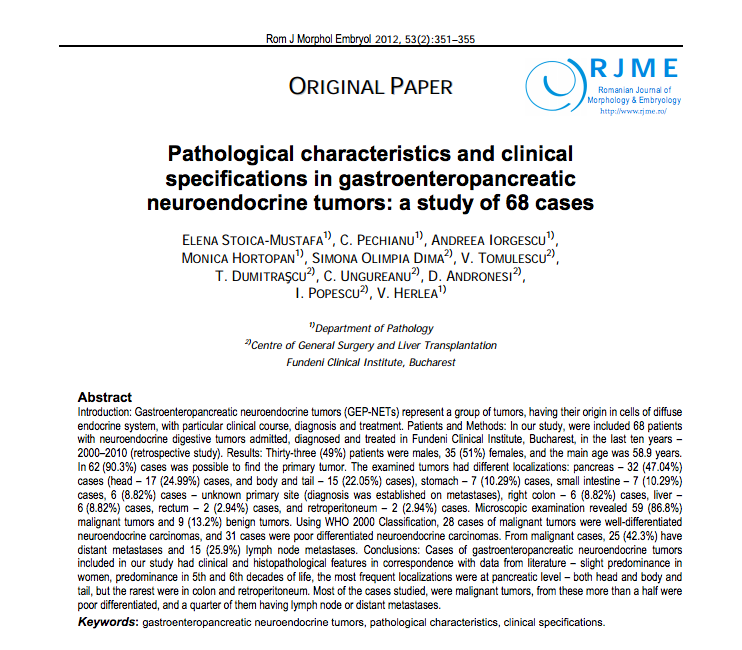Autori:
ELENA STOICA-MUSTAFA1), C. PECHIANU1), ANDREEA IORGESCU1), MONICA HORTOPAN1), SIMONA OLIMPIA DIMA2), V. TOMULESCU2), T. DUMITRAŞCU2), C. UNGUREANU2), D. ANDRONESI2), I. POPESCU2), V. HERLEA1)
1)Department of Pathology
2)Centre of General Surgery and Liver Transplantation, Fundeni Clinical Institute, Bucharest
2)Centre of General Surgery and Liver Transplantation, Fundeni Clinical Institute, Bucharest
Rezumat:
Introduction: Gastroenteropancreatic neuroendocrine tumors (GEP-NETs) represent a group of tumors, having their origin in cells of diffuse endocrine system, with particular clinical course, diagnosis and treatment.
Patients and Methods: In our study, were included 68 patients with neuroendocrine digestive tumors admitted, diagnosed and treated in Fundeni Clinical Institute, Bucharest, in the last ten years – 2000–2010 (retrospective study).
Results: Thirty-three (49%) patients were males, 35 (51%) females, and the main age was 58.9 years. In 62 (90.3%) cases was possible to find the primary tumor. The examined tumors had different localizations: pancreas – 32 (47.04%) cases (head – 17 (24.99%) cases, and body and tail – 15 (22.05%) cases), stomach – 7 (10.29%) cases, small intestine – 7 (10.29%) cases, 6 (8.82%) cases – unknown primary site (diagnosis was established on metastases), right colon – 6 (8.82%) cases, liver – 6 (8.82%) cases, rectum – 2 (2.94%) cases, and retroperitoneum – 2 (2.94%) cases. Microscopic examination revealed 59 (86.8%) malignant tumors and 9 (13.2%) benign tumors. Using WHO 2000 Classification, 28 cases of malignant tumors were well-differentiated neuroendocrine carcinomas, and 31 cases were poor differentiated neuroendocrine carcinomas. From malignant cases, 25 (42.3%) have distant metastases and 15 (25.9%) lymph node metastases.
Conclusions: Cases of gastroenteropancreatic neuroendocrine tumors included in our study had clinical and histopathological features in correspondence with data from literature – slight predominance in women, predominance in 5th and 6th decades of life, the most frequent localizations were at pancreatic level – both head and body and tail, but the rarest were in colon and retroperitoneum. Most of the cases studied, were malignant tumors, from these more than a half were poor differentiated, and a quarter of them having lymph node or distant metastases.
Patients and Methods: In our study, were included 68 patients with neuroendocrine digestive tumors admitted, diagnosed and treated in Fundeni Clinical Institute, Bucharest, in the last ten years – 2000–2010 (retrospective study).
Results: Thirty-three (49%) patients were males, 35 (51%) females, and the main age was 58.9 years. In 62 (90.3%) cases was possible to find the primary tumor. The examined tumors had different localizations: pancreas – 32 (47.04%) cases (head – 17 (24.99%) cases, and body and tail – 15 (22.05%) cases), stomach – 7 (10.29%) cases, small intestine – 7 (10.29%) cases, 6 (8.82%) cases – unknown primary site (diagnosis was established on metastases), right colon – 6 (8.82%) cases, liver – 6 (8.82%) cases, rectum – 2 (2.94%) cases, and retroperitoneum – 2 (2.94%) cases. Microscopic examination revealed 59 (86.8%) malignant tumors and 9 (13.2%) benign tumors. Using WHO 2000 Classification, 28 cases of malignant tumors were well-differentiated neuroendocrine carcinomas, and 31 cases were poor differentiated neuroendocrine carcinomas. From malignant cases, 25 (42.3%) have distant metastases and 15 (25.9%) lymph node metastases.
Conclusions: Cases of gastroenteropancreatic neuroendocrine tumors included in our study had clinical and histopathological features in correspondence with data from literature – slight predominance in women, predominance in 5th and 6th decades of life, the most frequent localizations were at pancreatic level – both head and body and tail, but the rarest were in colon and retroperitoneum. Most of the cases studied, were malignant tumors, from these more than a half were poor differentiated, and a quarter of them having lymph node or distant metastases.
Publicat:
Rom J Morphol Embryol 2012, 53(2):351–355
[gview file=”https://www.chirurgiehbp.ro/wp-content/uploads/2016/08/ARCHBPTH008.pdf”]

